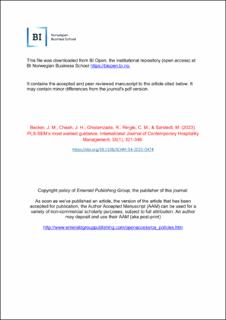PLS-SEM’s most wanted guidance
Peer reviewed, Journal article
Accepted version

Åpne
Permanent lenke
https://hdl.handle.net/11250/3094029Utgivelsesdato
2022Metadata
Vis full innførselSamlinger
- Scientific articles [2181]
Originalversjon
International Journal of Contemporary Hospitality Management. 2022, . 10.1108/IJCHM-04-2022-0474Sammendrag
Purpose – Partial least squares structural equation modeling (PLS-SEM) has attracted much attention from both methodological and applied researchers in various disciplines – also in hospitality management research. As PLS-SEM is relatively new compared to other multivariate analysis techniques, there are still numerous open questions and uncertainties in its application. This study aims to address this important issue by offering guidance regarding its use in contexts with which researchers struggle. Design/methodology/approach – The authors examine the most prominent questions and answers posed in a well-known PLS-SEM discussion forum. The authors do so by using a text analysis technique to identify the most salient topics. Findings – The data analysis identifies three salient PLS-SEM topics (i.e. bootstrapping and significance testing, higher-order constructs and moderation). Research limitations/implications – The results allow us to address the PLS-SEM community’s main methodological issues. The authors discuss each area separately and provide explanations and guidelines. Practical implications – The guidelines on the most important PLS-SEM topics provide decision-making and application aids. In this way, the authors make a decisive contribution to clarifying ambiguities when applying the PLS-SEM method in hospitality management research and other disciplines. Originality/value – There has as yet been no systematic analysis of this kind in the field of PLS-SEM; the authors, therefore, present the first research results. The findings and recommendations provide guidance for PLS-SEM applications in hospitality research and practice. PLS-SEM’s most wanted guidance
